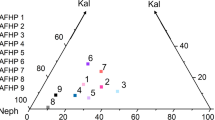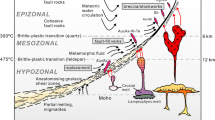Abstract
The increment method is adopted to calculate oxygen isotope fractionation factors for mantle minerals, particularly for the polymorphic phases of MgSiO3 and Mg2SiO4. The results predict the following sequence of18O-enrichment:pyroxene (Mg, Fe, Ca)2Si2O6>olivine (Mg, Fe)2SiO4 > spinel (Mg, Fe)2SiO4> ilmenite (Mg, Fe, Ca) SiO3>perovskite (Mg, Fe, Ca) SiO3. The calculated fractionations for the calcite-perovskite (CaTiO3) System are in excellent agreement with the experimental calibrations. If there would be complete isotopic equilibration in the mantle, the spinel-structured silicates in the transition zone are predicted to be enriched in18O relative to the perovskite-structured silicates in the lower mantle but depleted in18O relative to olivines and pyroxenes in the upper mantle. The oxygen isotope layering of the mantle might result from differences in the chemical composition and crystal structure of mineral phases at different mantle depths. Assuming isotopic equilibrium on a whole earth scale, the chemical structure of the Earth’s interior can be described by the following sequence of18O-enrichment:upper crust>lower crust>upper mantle>transition zone>lower mantle>core.
Similar content being viewed by others
References
Kyser T.K., O’Neil, J.R., Carmichael, I. S. E., Oxygen isotope thermometry of basic lavas and mantle nodule,Contrib. Mineral. Petrol., 1981, 77: 11.
Chiba, H., Chacko, T., Clayton, R. N. et al., Oxygen isotope fractionations involving diopside, forsterite, magnetite and calcite:Application to geothermometry,Geochim. Cosmochim. Acta, 1989, 53: 2985.
Rosenbaum, J. M., Walker, D., Kyser, T. K., Oxygen isotope fractionation in the mantle,Geochim. Cosmochim. Acta, 1994, 58: 4767.
Rosenbaum, J. M., Mattey, D., Equilibrium garnet-calcite oxygen isotope fractionation,Geochim. Cosmochim. Acta, 1995, 59: 2839.
Gautason, B., Chacko, T., Muehlenbachs, K., Oxygen isotope partitioning among perovskite (CaTiO3), cassiterite (SnO2) and calcite (CaCO3),Abstr. Prog. Joint Annual Meeting GAC & MAC, Edmonton, 1993, A34.
Schütze, H., Der Isotopenindes-eine Inkrementmethode zur näherungsweisen Berechnung von Isotopenaustauschgleichgewichten zwischen kristallinen Substanzen,Chem. Erde, 1980, 39: 321.
Zheng, Y.-F., Calculation of oxygen isotope fractionation in metal oxides,Geochim. Cosmochim. Acta, 1991, 55: 2299.
Zheng, Y.-F., Calculation of oxygen isotope fractionation in anhydrous silicate minerals,Geochim. Cosmochim. Acta, 1993, 57: 1079.
Zheng, Y.-F., Oxygen isotope fractionation in metal monoxides,Mineral. Mag., 1994, 58A: 1000.
Muller, O., Roy, R.,The Major Ternary Structural Families, Berlin, Heidelberg, New York:Springer-Verlag, 1974, 487.
Kieffer, S. W., Thermodynamics and lattice vibration of minerals:5. Application to phase equilibria, isotopic fractionation, and high pressure thermodynamic proporties,Rev. Geophys. Space Phys., 1982, 20: 827.
Clayton, R. N., Goldsmith, J. R., Mayeda, T. K., Oxygen isotope fractionation in quartz, albite, anorthite and calcite,Geochim. Cosmochim. Acta, 1989, 53: 725.
Polyakov, V. B., Kharlashina, N. N., Effect of pressure on equilibrium isotopic fractionation,Geochim. Cosmochim. Acta, 1994, 58: 4739.
Hoefs, J.,Stable Isotope Geochemistry, 3rd ed., Berlin, Heidelberg, New York:Springer-Verlag, 1987, 241.
Valley, J. W., Taylor, H. P. Jr., O’Neil, J. R., Stable isotopes in higher temperature geological processes,Reviews in Mineralogy, 1986, 16: 570.
Fowler, M. B., Harmon, R. S., The oxygen isotope composition of lower crustal granulite xenoliths,Granulites and Crustal Evolution (eds. Vielzeuf, D., Vodal, Ph.), Dordrecht:Kluwer Academic Publishers, 1990, 493–506.
Schubert, G., Turcotte, D. L., Phase transition and mantle convection,J. Geophys. Res., 1971, 76: 1424.
Chritsensen, U. R., Yuen, D. A., Layered convection induced by phase transitions,J. Geophys. Res., 1995, 90: 10291.
Tackley, P. J., Mantle dynamics:Influence of the transition zone,Rev. Geophys. (suppl.), US National Report to IUGG, 1995, 275–282.
Author information
Authors and Affiliations
Additional information
Project supported by the National Natural Science Foundation of China and the Chinese Academy of Sciences.
Rights and permissions
About this article
Cite this article
Zheng, Y., Wei, C., Zhou, G. et al. Oxygen isotope fractionation in mantle minerals. Sci. China Ser. D-Earth Sci. 41, 95–103 (1998). https://doi.org/10.1007/BF02932427
Received:
Issue Date:
DOI: https://doi.org/10.1007/BF02932427




